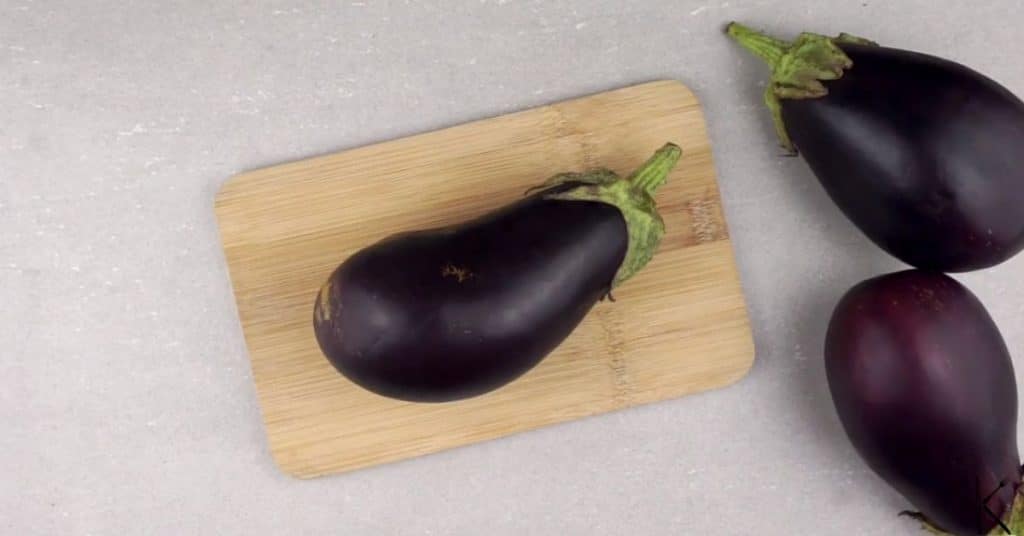In summary: Yes, you can freeze eggplant to prolong its shelf life, but expect a change in texture due to its high water content, making it best suited for cooked dishes like dips, curries, and sauces.
Also known as aubergine or brinjal, the versatile eggplant can be used in casseroles, soups, curry, stir-fry, and as a dip. Although commonly used as a vegetable, eggplant is botanically classified as a fruit.
These purple egg-shaped fruits don’t last very long and discolor quickly once sliced due to oxidation. This makes it tricky to keep more than what you require for a meal or 2 in stock.
If you’ve got a big harvest or have more on hand than you need, the best way to preserve eggplant is by freezing it. Due to its high moisture content, there are a few things to consider when storing eggplant in the freezer.
Here is a full guide to freezing eggplant.
Can Eggplant Be Frozen?
Freezing eggplant is one of the best ways to prolong its shelf life. However, it is important to note that due to its naturally high water content, the eggplant won’t be firm once the formed ice crystals defrost after freezing.
Considering that eggplant is generally only eaten cooked, the textural change will not be very noticeable.
If the eggplant seems too watery once thawed, it will still be ideal for use in dips, curry dishes, pasta sauces, and soup. Eggplant which you intend to fry at a later stage can be breaded before freezing.
Only freeze completely ripe fresh eggplant with a firm texture. Eggplant that has started to wrinkle or develop soft spots should be used immediately or thrown away as it will not freeze well.
Although all eggplant types can be frozen, the traditional black or dark-purple varieties hold up best in the freezer compared to the smaller purple Chinese and Thai types.

How To Freeze Eggplant
There is more than one way to freeze eggplant. We recommend that you freeze eggplant using one of the below two methods.
Option 1: Raw
Step 1: Clean
Wash the fresh eggplant to remove any dirt and dry it with a clean dishtowel. Cut off the top stalk and bottom end of the eggplant. Peel the eggplant if preferred, however, this is optional depending on how you wish to use it after freezing.
Step 2: Slice
Cut the eggplant into slices approximately 1/3 inch thick.
Step 3: Blanch
Blanching eggplant before freezing is important to prevent color and flavor loss. The heat destroys ripening enzymatic activity which causes the eggplant to slowly deteriorate over time.
The point of blanching is, however, not to fully cook the eggplant as you still want the texture to remain firm.
Adding lemon juice to the blanching water will prevent discoloring.
Bring a large stockpot of water to a rolling boil and add ¼ cup of lemon juice for every 2 liters of water. Place the eggplant into the pot of boiling water for four minutes. Keep a separate large bowl of ice water nearby.
After 4 minutes, drain the eggplant and immediately place it into the ice water to stop the cooking process. Let it cool completely.
Step 4: Dry
Once cooled, drain the eggplant slices and pat dry lightly with paper towels. Additional moisture on the eggplant will form large ice crystals on freezing and further damage the texture, resulting in a mushy mess when thawed.
Step 5: Pack
Divide the slices up into the desired portion sizes you may want to use at any given time. Place each portion into a resealable freezer safe bag. Press out any excess air at the top of the bag before sealing. Alternatively you can also use freezer safe containers.
Step 6: Label and Freeze
Label the bag with the date and place it in the freezer. This will help you to keep track of how long the eggplant has been stored.
Option 2: Puree
You can freeze eggplant purée pre-cooked when using it in a dip, sauce, or soup.
Step 1: Wash and Prick
Wash the eggplant and cut off the top green stem. Using a fork, prick the eggplant skin a few times to prevent it from bursting while cooking.
Step 2: Cook
Roast the whole eggplant until it is soft. Alternatively, you can also steam it.
Step 3: Cool
Let the roasted eggplant cool down completely. To speed up the cooling process cut it in half lengthwise to allow the steam and heat to escape.
Step 4: Pack
Once cooled and halved, scoop out the flesh of the cooked eggplant. Place the soft fleshy puree into resealable freezer bags. Do not overfill the bags. Water expands on freezing and overfilling the bags can cause them to burst during the freezing process.
Step 5: Seal, Label, and Freeze
Press out as much air as possible before sealing the bags. Label each bag with the date of freezing as well as the contents and place it in the freezer.
How To Thaw Frozen Eggplant
Eggplant which has been sliced can be cooked from frozen. Place the frozen eggplant slices directly into the pan, pot, or stir-fry for cooking.
Eggplant puree can be used directly from frozen if adding it to a soup or casserole.
If you need to defrost the eggplant for use in a dip or sauce, thaw it in the fridge overnight or place the sealed bag in a bowl of room-temperature water to speed up the thawing process.
Types of Eggplant
The most common type of eggplant has purple skin, an oblong shape, and a spongy cream-colored interior with small seeds. Eggplant is generally eaten cooked. The skin and seeds are also edible once prepared.
Cooking allows the spongy flesh to absorb oils and flavors, making it a great base for a variety of cuisines and flavor profiles.
Eggplants also comes in speckled and white-skinned varieties, in various sizes and lengths.
Regardless of the type of eggplant you use, it can be steamed, roasted with olive oil, stewed, stir-fried, pan-fried, battered and deep-fried, curried, or pickled. Eggplant can also be stuffed and is often used in sauces or dips.
FAQs
Conclusion
We love eggplant because there are so many easy ways to enjoy these vegetables. You can cook eggplant by steaming, frying, or roasting. If you like keeping your freezer filled with ready to use meals, eggplant casserole, curry, or eggplant parmesan are great choices.
Whether you are freezing eggplant dip, sliced pieces, or a ready-to-cook parmesan, make sure it is packaged in airtight containers or freezer bags to keep air and moisture out for the best results.
Up next: Can You Freeze Zucchini?









